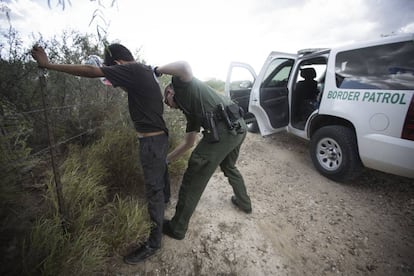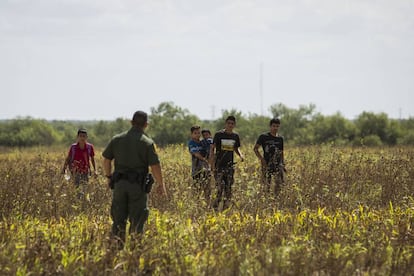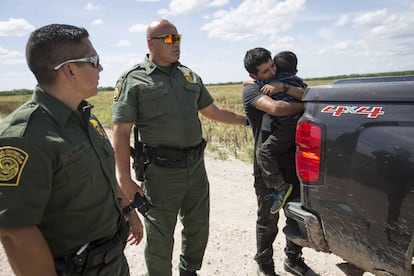Why the reality at the Mexican border doesn’t match Donald Trump’s vision
EL PAÍS observes the work of US officers at one of the hottest spots for migration in Texas


Francisca Guevara is six months old and she has been traveling for the last five months in her mother’s arms. They left Copán, Honduras and walked until Wednesday afternoon when they crossed the Rio Grande between Tamaulipas and Texas. Francisca has red abrasions on her neck and back. Lilia Guevara, her mother, says it is the heat and humidity that have caused the irritations on her skin. The Guevaras met 22 other people at the river, 10 of whom were children. They crossed the water in a small boat but border patrol agents detected them before they reached the other shore. The officers were still taking down their information when another group of more than 20 people arrived, half of whom were also underage. One mother fainted in front of the agents because she had been traveling for days without food. The day before, 200 undocumented immigrants passed through the same area. A normal day, repeated every day, at the Texas border.
“I don’t call these apprehensions; I call them rescues,” says Manuel Padilla, chief of the Rio Grande Valley Border Patrol Sector. Padilla sees the situation at the border not as a threat to the country’s security but as a humanitarian emergency that requires a response. These arrests, agents say, are the biggest challenge at the US-Mexican border.
Republican presidential candidate Donald Trump built his campaign from scratch on his vision of the southern border as a place engulfed in chaos and on his plan to build a wall to contain the avalanche of “criminals” coming from Mexico. “They’re bringing drugs. They’re bringing crime. They’re rapists,” Trump said in his first 10 minutes on the campaign trail. Border patrol high command and agents on the ground are exceptionally careful not to make political remarks. But they show us where authorities have already built walls, mostly in urban areas where, otherwise, one could walk across the border line. They also show the military surveillance technology used along the rest of the frontier where 17,000 agents have been deployed. The greatest challenge, they say, is managing the arrival of desperate families. But even this predicament, they insist, is under control.
Trump built his campaign from scratch on his vision of the southern border as a place engulfed in chaos
In 2014, border agents arrested 63,000 minors, 46,000 of whom were picked up in the Rio Grande Sector. McAllen became ground zero for illegal immigration in the United States, and the focus of this new phenomenon for which there was no protocol or infrastructure. Agent Isaac Villegas remembers the day he was on patrol in Hidalgo County, Texas when, suddenly, children started emerging from the bushes. It was a group of 26 minors. “It looked like a nursery. Kids kept coming out, grabbing onto my leg. They had telephone numbers written on their skin, papers with information in their diapers.” And so it went every day for a year in what became the crisis of unaccompanied undocumented minors. US Customs and Border Protection receives a $13-billion budget every year but no one had foreseen the need for humanitarian aid services. Sordid detention centers that should be filled with smugglers were used to warehouse mothers and children.
In 2015, the “rescues” of minors fell by half but the number of unaccompanied children crossing the border is on the rise again this year. There have been 156,000 arrests in the Rio Grande Sector so far. Forty-four percent of those detained were families or unaccompanied minors. Arrests made along the entire border so far this year – 332,000 – have already surpassed the total number for last year.
It is difficult for American border authorities to share these numbers and yet insist that the situation is under control. Their position can only be understood from a historical perspective. In 2000, US Border Patrol detained 1.6 million people. In 1992, they had apprehended 560,000 individuals in San Diego alone. That wave of illegal immigration led to a spiral of xenophobia that still affects California’s policies today. A wall, high-tech equipment and the deployment of more agents reduced that number to 68,000 in 2010. Most illegal immigrants moved toward El Paso and then through Arizona as authorities built more walls along the border and deployed more security personnel armed with high-tech surveillance material. Today, McAllen, a city in the Rio Grande Sector, is ground zero for illegal immigration. The number of undocumented people arrested in this area is unparalleled but so is the quality of the surveillance.

There are fewer reports about immigration in McAllen today because agents are more prepared. Two years ago, there were no personnel or facilities to handle the influx of immigrants. “The criticisms in 2014 were valid,” says Padilla. But now families are “processed” in clean, efficient centers where authorities tell the undocumented traveler whether he can continue his journey or not within a few days. Despite the hundreds of arrests made every day, southern Texas no longer has that atmosphere of chaos. “Today we have a center to process them and transfer them to other agencies. The agreements with these agencies did not exist before. We have the capacity to process up to 1,000 people a day. We are much better prepared,” Padilla explains.
Experts on border security say authorities have already built walls where they can be useful, in urban areas where they slow down the flow of people but nothing else. The drug traffickers who worry Donald Trump do not get discouraged because of a wall. US Customs and Border Protection seized 100 tons of drugs in 2015 along the fortified California border. “What stops drugs are not walls, but information and cross-border collaboration,” says Padilla. “I am not a proponent of the wall at this border. What we call a wall has its function in different parts of the border. The threat you face and the terrain are what dictate the equipment you have to use in different parts of the border. What we need here and what we are deploying is technology to find out what’s happening. Basically, military technology that will allow us to see from top to bottom. We have cameras up on poles watching day and night and they give us constant surveillance.”
What stops drugs are not walls, but information and cross-border collaboration
Images of immigrants crossing by the thousands in the Rio Grande area give the viewer a feeling of the permeability of the border and ensuing chaos. But there are patrol agents and a nine-foot wall on the other side. Crossing the river in a boat is relatively easy and EL PAÍS watched as Lilia Guevara and her baby girl, Francisca, made the journey. But that successful trip proved completely futile. The entire area is a mousetrap where every square meter is under surveillance. Desperate Central American families that cross the border have no intention of escaping. In fact, they themselves call 911 to come get them. They want to enter the American justice system and fight for refugee status. “I ask God to touch their hearts so they help us,” says Luis Portillo, a 23-year-old Honduran man who hugs his five-year-old son, Jonathan Roberto, while agents wait to put him in a Border Patrol vehicle.
The mistrust with which the rest of the country looks at the border is at odds with the feeling of normalcy in McAllen, says Sister Norma Pimentel. The city offered its assistance during the 2014 unaccompanied minors crisis. “Most of us who live at the border understand immigration because we are also immigrants – we are from here, we have been experiencing it since we were born.” Pimentel started an emergency help center at Sacred Heart Church in downtown McAllen that still serves about 100 people every day. The families and minors that US Immigration and Customs Enforcement allows to continue their journey north because officials do not have any urgent reasons to deport them or keep them in custody, end up at the McAllen bus station and then at this church, where they can rest before they get back on the road.

Pimentel does not shy away from criticizing detention centers and the coldness with which agents treat immigrants. Yet she says: “The border is under control. They paint a disastrous, out-of-control image but that’s not true. Border patrol and all those in charge of security at the border have it under control. The presidential candidate [she refuses to use Trump’s name] is using it as a platform to promote his position. Professionals know how to identify a criminal or someone who is carrying drugs. They are doing their job. The fact that there are many people who come asking for protection is not the same as it being out of control.”
English version by Dyane Jean François.
Tu suscripción se está usando en otro dispositivo
¿Quieres añadir otro usuario a tu suscripción?
Si continúas leyendo en este dispositivo, no se podrá leer en el otro.
FlechaTu suscripción se está usando en otro dispositivo y solo puedes acceder a EL PAÍS desde un dispositivo a la vez.
Si quieres compartir tu cuenta, cambia tu suscripción a la modalidad Premium, así podrás añadir otro usuario. Cada uno accederá con su propia cuenta de email, lo que os permitirá personalizar vuestra experiencia en EL PAÍS.
En el caso de no saber quién está usando tu cuenta, te recomendamos cambiar tu contraseña aquí.
Si decides continuar compartiendo tu cuenta, este mensaje se mostrará en tu dispositivo y en el de la otra persona que está usando tu cuenta de forma indefinida, afectando a tu experiencia de lectura. Puedes consultar aquí los términos y condiciones de la suscripción digital.










































